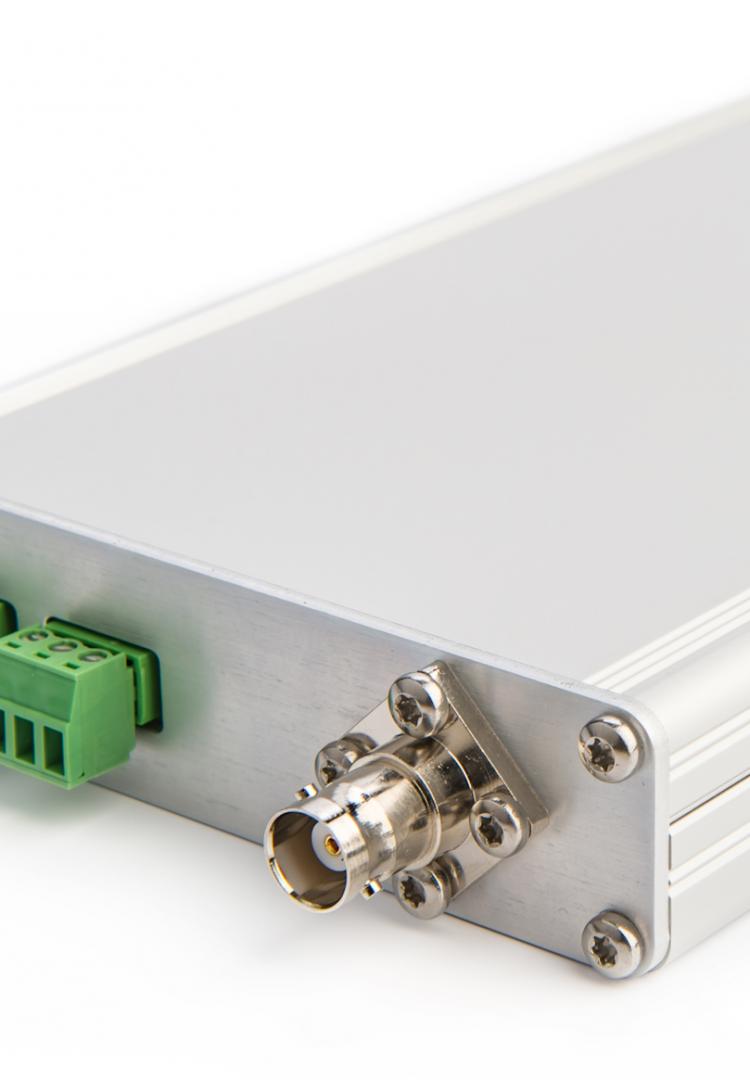
FIDCU-4 Description
The FIDCU-4 is the standard electrometer detector controller for GC and possible other applications. Primary application targets are: FID, PDD and PID.
Dual 24-bit A/D combined with auto-ranging
The data acquisition uses a contiguous auto-ranging principle based on input gain control with oversampling techniques. This results in contiguous signal conversion from the lowest signal levels up-to the highest input level. Data are presented in a signed 32-bit value which relieves the user from any range control or signal handling.
Communication
Data and command communication runs via a multi-drop RS485 connection using the secure NextGCTM protocol. Sample data handling includes a large internal FIFO data buffer with re-read capabilities. This prevents the loss of data, even in less ideal communication environments.
Optically Isolated Front-End
Only a simple +24V power supply is needed, which makes the complete interfacing very simple in most embedded and stand-alone applications.
The FIDCU-4 analog electronics section is fully isolated from both the +24V power supply as well as the RS485 communication line, providing easy grounding on the secondary (FID) side to provide optimum noise-free conditions as required for the high resolution data acquisition.
Design
The design is based on proven technology but packed in a smaller form factor and compact electronics optimized specifically for this application.
The unit contains all required electronics on board:
- Dual 24-bit low-noise A/D with Analog Auto-Ranging Front-End yielding contiguous 32-bit digital signal with 0.5 fA resolution.
- Programmable High Voltage Ionisation Generator
- FID Ignition Current Generator
- Ignition Current Measurement to detect coil failure
- External Trigger Input (optional)
The module can create both hardware or software generated test chromatograms (50% peak steps) for signal quality and CDS data processing tests.
Specifications
Input Resolutions and Range
The module is auto-ranging as provides a signed 32-bit word as result with a resolution of 0.5 fA.
Polarization Voltage
The polarization voltage can be positive and negative and is set during production under software control (PWM value saved in EEPROM memory).
Range up to 300Vdc for FID and other ionisation detectors.
Special low voltage range for the PID family of detectors (typ -10V..10V).
Sample rate
Available, settable, sample rates are 200, 150, 120, 100, 60, 50, 30, 25, 15, 12.5, 7.5 and 6.25 sps.
The conversion is optimized for both 50 Hz and 60 Hz environments (special digital filter).
Higher/lower sample rates are available on special request.
Note: the FIDCU-4 internally uses an ADC acquisition rate that is 4x the sample rate for the proper implementation of the auto-range algorithm.
Noise level
Max noise level is 30 fApp for a real input signal at 50 sps.
The nominal test level is 5 pA using the 5 Gohm internal shift resistor and this test is executed during the automated production Calibration & Test procedure.
Data Buffer
The internal FIFO data buffer is used to provide sample buffering. This buffer is only needed to handle the NextGC bus latency, but can be selected to any size as needed and allowed by the used internal RAM memory.
Communication
The FIDCU-4 uses the RS485 NextGC bus and protocol and is connected using the standard RJ25 or ERNI 6-pin connector.
The communication uses galvanic isolated data paths allowing local grounding of the detector signal and case grounding. A slew rate limited RS485 interface is used for lowest noise and EMI.
Power Supply
Power is taken from the NextGC bus (+24V). This voltage is internally converted to the needed voltages and uses galvanic isolation. The module casing (and detector grounding) can be and must be connected to a local grounding, providing extra options for signal quality handling.
FID Ignite
To make the FIDCU-4 fully independent of external power supplies (except the +24V) the ignite power is generated internally in the controller using an isolated high-current DCDC converter. The default setting is +3.6V/3.3A but other levels can be implemented on request.
Optionally a high-power relay can be offered inside the FIDCU-4 to allow to use an external ignition power source.
Connections
The FID is connected via a very high impedance BNC jack.
The Igniter, Relay and HV connection use screwed plug-in connectors.
NextGC communication uses the standard RJ25 connector and/or ERNI 6way connectors.
Case
Industrial shielded case with dimensions: 160 x 26 x 105 without BNC connector and mounting material.
The case and packaging is optimized for production and calibration while maintaining the stringent electrometer performance.
